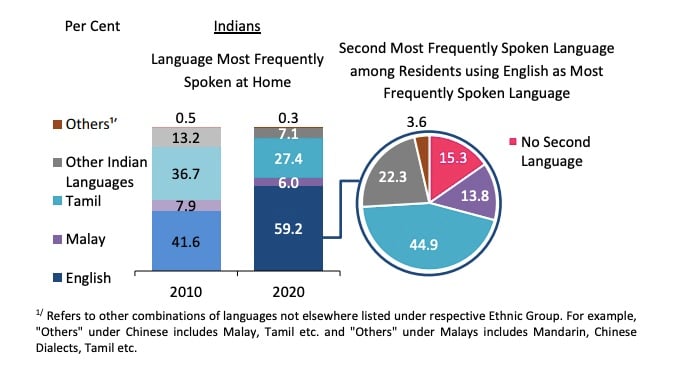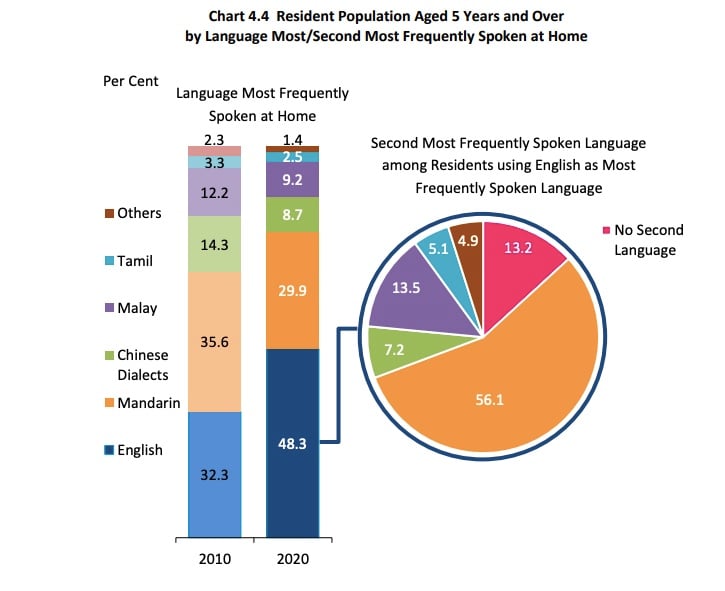SINGAPORE: President Tharman Shanmugaratnam praised Tamil teachers in a Facebook post on Sunday (Sept 24) after attending the Singapore Tamil Teachers Union’s (STTU’s) annual dinner on Saturday night.
He wrote: “Let’s applaud our Tamil teachers. They have been working hard and creatively to keep the language alive, today and for the future. It matters not just for the Tamil-speaking community, but all Singaporeans, so that we keep our vibrant and diverse multiculturalism. It is a challenge. With each passing decade, fewer students speak their mother tongues frequently at home.”
Indeed, Tamil is on the wane even at home.

English has become the language most frequently spoken at home by the majority of Indians in Singapore.
The 2020 population census shows 59.2 per cent of the Indians speak English most often at home, up from 41.6 per cent in 2010.
English has become the language spoken most frequently at home by the largest group of Singaporeans over the last decade.

The 2020 census shows 48.3 per cent of Singaporeans speak English most frequently at home, up from 32.3 per cent in 2010, when 35.6 per cent spoke Mandarin and Chinese dialects most often at home.
Now, 47 per cent of the Chinese speak English most frequently at home, up from 32.6 per cent in 2010.
English is spoken most often at home by more Malays, too, up from 17 per cent to 39 per cent.
But Indians are the ethnic group where the majority speaks English most frequently at home.
Now, just 24.7 per cent of the Indians speak Tamil most often at home, down from 36.7 per cent in 2010.
Seven per cent of the Indians speak other Indian languages most frequently at home, while 6 per cent speak Malay.
Incidentally, 13.8 per cent of the Indians are literate in English only, up from 12.5 per cent in 2010. (The figures are almost the same for the Chinese: 11.7 per cent, up from 11.1 per cent.
President Tharman said:
“For the Tamils, there is a further challenge. Ethnic integration in our neighbourhoods and schools – completely essential for Singapore – means we do not have a concentration of Tamils in one place. So the naturalness of speaking the language from young, daily with neighbours, at the stores, or on the swings, does not come easily.
The solution is to make language learning a joyful experience. Especially by connecting it to culture, in ways that appeal naturally to students. Such as songs (including rap, and the songs that come with dance), videos, games.”
President Tharman praised the Ministry of Education and the Singapore Tamil Teachers Union (STTU) for “making progress on this through the Tamil Language Learning and Promotion Committee. The aim is simple – for students to enjoy using the language beyond the classroom.”
President Tharman noted the Singapore Tamil Teachers Union’s various initiatives.
“Besides their efforts at home, they have also been at the forefront of international exchange, especially among countries where Tamils are a minority.
Their earlier leaders, S Samikannu, AR Mashuthoo and VRP Manickam deserve much credit. A new leadership team, led by Danapal Kumar, with several young teachers and many more women, is now taking the effort forward. Inspiring each other with new energy and ideas.”

